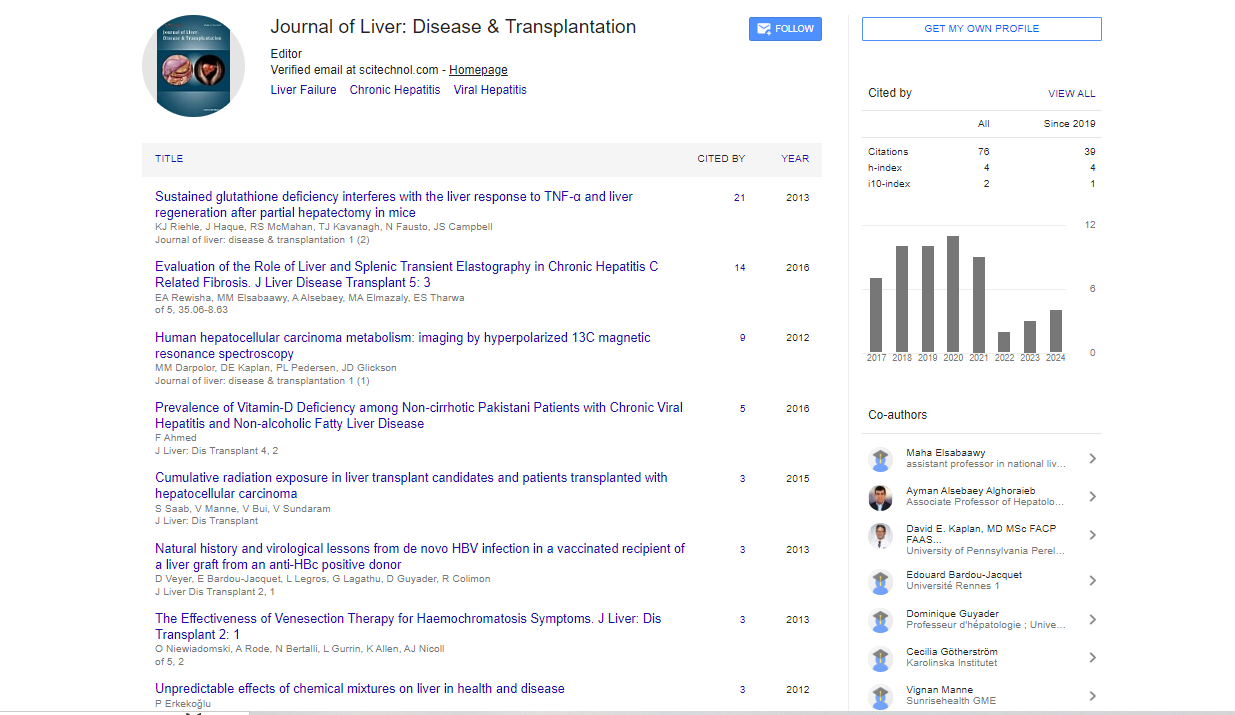Commentary, J Liver Disease Transplant Vol: 13 Issue: 4
Novel Approach in Diagnosis and Monitoring Liquid Biopsies in Liver Cancer
David Cillo*
1Department of Hepatobiliopancreatic, Gesu Children's Hospital, Rome, Italy
*Corresponding Author: David Cillo,
Department of Hepatobiliopancreatic, Gesu
Children's Hospital, Rome, Italy
E-mail: cillodd@hpp.opbg.net
Received date: 28 November, 2024 Manuscript No. JLDT-24-156907;
Editor assigned date: 02 December, 2024, PreQC No. JLDT-24-156907 (PQ);
Reviewed date: 16 December, 2024, QC No. JLDT-24-156907;
Revised date: 23 December, 2024, Manuscript No. JLDT-24-156907 (R);
Published date: 30 December, 2024, DOI: 10.4172/2325-9612.1000284.
Citation: Cillo D (2024) Novel Approach in Diagnosis and Monitoring Liquid Biopsies in Liver Cancer. J Liver Disease Transplant 13:4.
Abstract
Description
Liver cancer, particularly Hepatocellular Carcinoma (HCC), represents one of the most common and lethal malignancies worldwide. Early detection and effective monitoring are important for improving prognosis and patient outcomes. Traditionally, liver cancer diagnosis relies on imaging techniques, such as ultrasound, CT scans and MRI, combined with invasive procedures like tissue biopsy. While effective, these methods have limitations, including invasiveness, procedural risks and difficulties in capturing the dynamic heterogeneity of tumors. Liquid biopsies, a non-invasive diagnostic method, have emerged as a transformative approach in oncology. By analyzing circulating tumor components in blood or other body fluids, liquid biopsies offer a promising path for early detection, real-time monitoring and personalized treatment of liver cancer. Liquid biopsies involve the collection and analysis of non-solid biological samples, typically blood, to detect and characterize cancer-related biomarkers. These biomarkers include Circulating Tumor Cells (CTCs), cell-free Deoxyribonucleic Acid (cfDNA), circulating tumor DNA (ctDNA), exosomes and microRNAs (miRNAs). Unlike traditional biopsies, which require invasive sampling of tumor tissues, liquid biopsies provide a less invasive, repeatable and dynamic tool for understanding the molecular and genetic landscape of cancers. In liver cancer, liquid biopsies hold particular significance due to the challenges of accessing liver tissues, the high recurrence rate of HCC and the need for continuous monitoring during treatment.
Liquid biopsies enable the detection of liver cancer at an earlier stage, often before the onset of symptoms. The integration of ctDNA and miRNA analysis with existing screening protocols, such as Alpha- Fetoprotein (AFP) testing, enhances sensitivity and specificity. This is particularly beneficial for high-risk populations, including patients with chronic hepatitis B or C, liver cirrhosis, or Non-Alcoholic Steatohepatitis (NASH). The molecular profiling of liquid biopsy components allows for the identification of actionable genetic alterations and pathways. This information guides the selection of targeted therapies, such as tyrosine kinase inhibitors or immune checkpoint inhibitors improving treatment efficacy and reducing unnecessary toxicity. Liquid biopsies provide a real-time, non-invasive method to monitor treatment response. Changes in ctDNA levels or mutational burden during therapy correlate with tumor dynamics, enabling early assessment of treatment efficacy and timely adjustments in therapeutic strategies. HCC is characterized by a high recurrence rate even after curative treatments like surgical resection or ablation. Liquid biopsies facilitate the early detection of Minimal Residual Disease (MRD) and recurrence through ctDNA or CTC analysis. This aids in timely intervention and improved prognosis.
Liquid biopsies offer several advantages over traditional diagnostic methods. Reduced procedural risks and patient discomfort compared to tissue biopsies. Ability to perform serial sampling for longitudinal monitoring. Capture of systemic tumor characteristics, addressing tumor heterogeneity. Potential to identify cancer at its earliest stages. Facilitates timely adjustments in treatment plans. Despite their potential, liquid biopsies face certain challenges: The low abundance of tumor-derived components, such as ctDNA and CTCs, in blood can limit detection sensitivity, particularly in early-stage cancers. Lack of standardized protocols for sample collection, processing and analysis hampers reproducibility and comparability across studies. Advanced technologies required for liquid biopsy analysis, such as Next- Generation Sequencing (NGS) and droplet digital Polymerase Chain Reaction (ddPCR), can be costly and resource-intensive. The clinical significance of certain biomarkers, such as low-frequency mutations or specific miRNA profiles, requires further validation. Integration of liquid biopsies into routine clinical practice necessitates regulatory approval and adherence to ethical standards, particularly in the context of genomic data.
Conclusion
Liquid biopsies represent a new approach in the diagnosis and management of liver cancer. Their non-invasive nature, coupled with the ability to provide real-time insights into tumor dynamics, holds immense potential to improve patient outcomes. While challenges remain, advancements in technology, biomarker discovery and clinical integration are paving the way for widespread adoption of liquid biopsies in liver cancer care. As study progresses, liquid biopsies are poised to become an indispensable tool in precision oncology, transforming the landscape of liver cancer diagnosis and treatment.
 Spanish
Spanish  Chinese
Chinese  Russian
Russian  German
German  French
French  Japanese
Japanese  Portuguese
Portuguese  Hindi
Hindi 